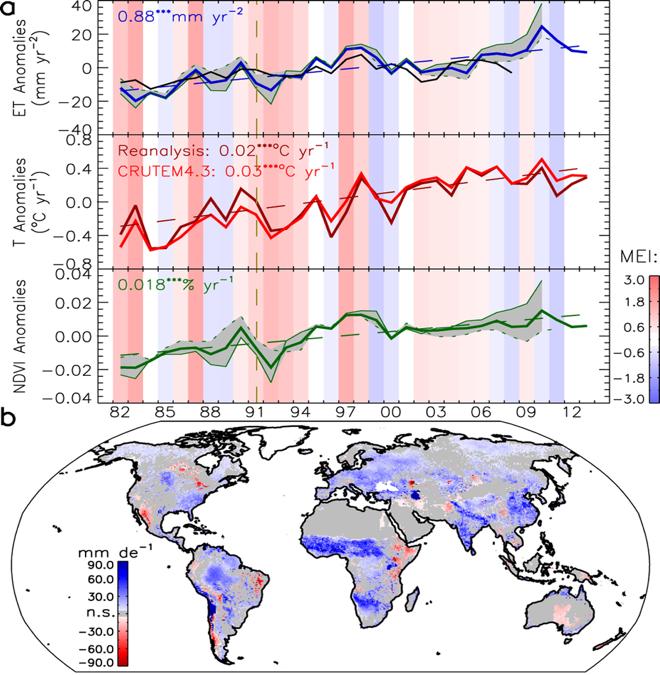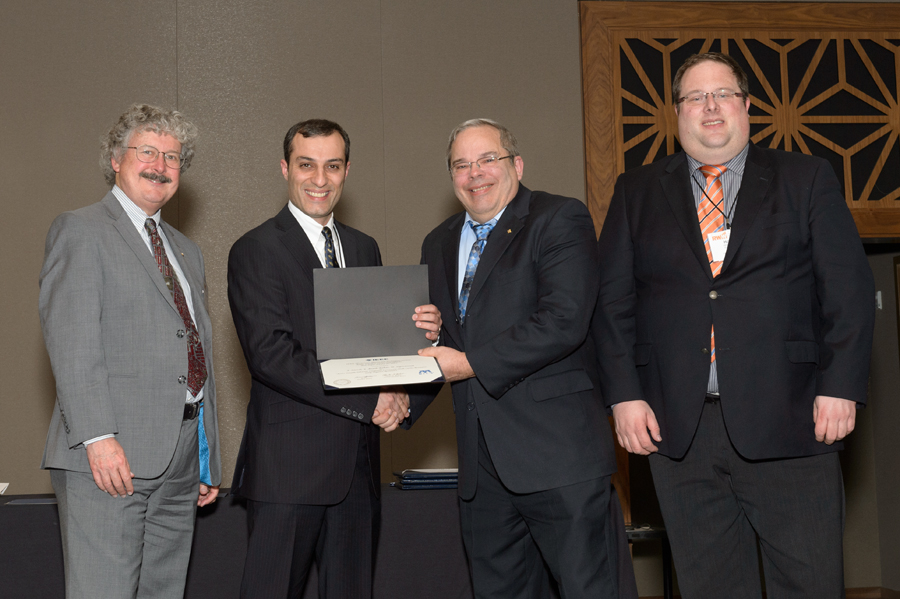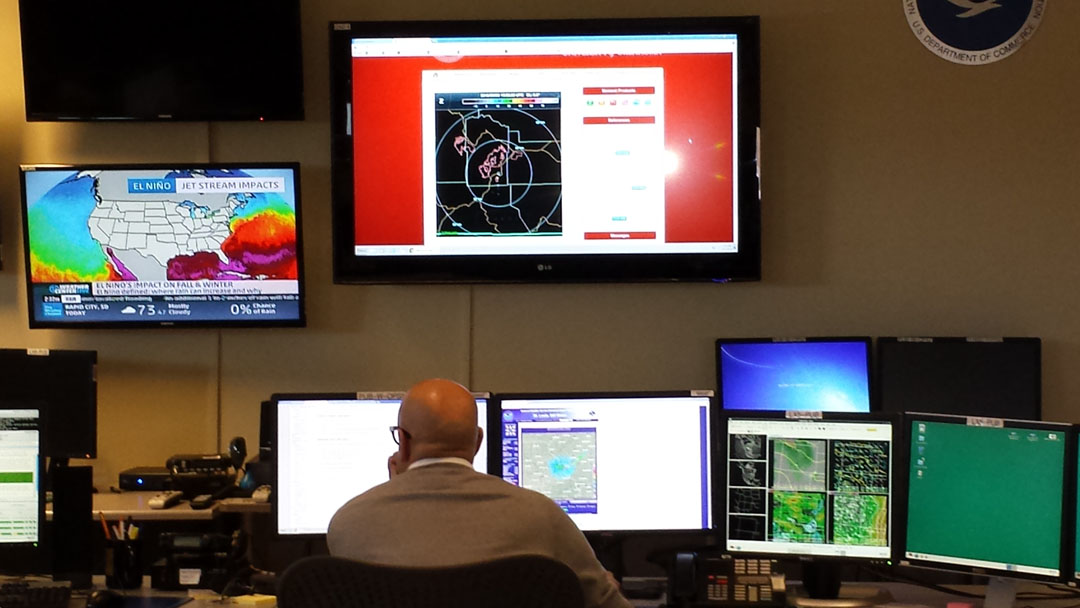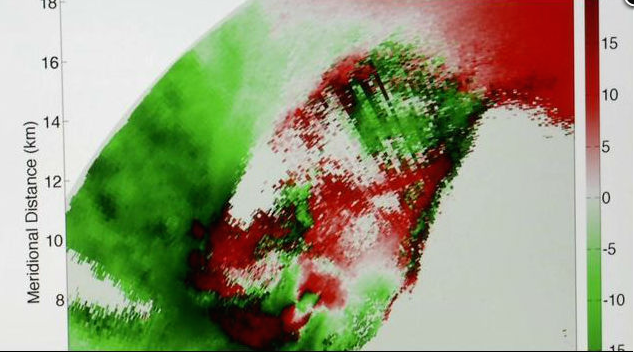News Archive

ARRC Professor, Dr. Phillip Chilson, along with colleagues from three other universities, received a $6 million grant from the National Science Foundation, talked about developing unmanned aerial vehicles for high quality measurements of the lower atmosphere. Visit the PBS News website for the full story.

A team of OU researchers, led by Ke Zhang (CIMMS), Yang Hong (CEES and ARRC), and Jonathan Gourley (NSSL/CIMMS), recently discovered that global vegetation greening, combined with climate change, promote multi-decadal rises of global land evapotranspiration, accelerating global water cycles and potential regional drought risks. The findings were published on Nature Publishing Group Scientific Report magazine's website.
The research team first generated a long-term global satellite record of land evapotranspiration using remote sensing satellite data since 1982. They investigated multi-decadal changes looking at trends between 1982 and 2013. In addition to global evapotranspiration trends, they examined vegetation greenness and general climate data including temperature, precipitation and cloudiness. Collectively, results show that during the past 32 years general increasing trends in both plant growth and evaporation with recent climate change mainly driven by vegetation greening and rising atmosphere moisture deficits. The study predicts that a continuation of these trends will likely exacerbate regional drought-induced disturbances, especially during regional dry climate phases associated with strong El Nino events.

ARRC Postdoctoral Fellow, Dr. Shahrokh Saeedi, received the second place for his paper titled “Active Tunable Substrate Integrated Evanescent-mode Cavity Resonator Using Negative Resistance” at the 2016 IEEE Radio and Wireless Symposium held recently in Austin, Texas. Congratulations Shahrokh!

Congratulations to ARRC/ECE graduate student John Lake on being selected as the third place winner in the poster presentation category of the American Meteorological Society and EIPT (Environmental Information Processing Technologies) Conference Student Competition. John’s poster was titled “Improving Radio Frequency Interference Mitigation Strategies at the National Weather RadarTestbed.”

Dr. Pierre Kirstetter (ARRC/NOAA/NSSL) is leading a team of OU and NSSL researchers selected by the NASA Global Precipitation Measurement (GPM) mission as Science Team Members. GPM is an international network of research and operational satellites that provides the next-generation global observations of rain and snow, centered on an advanced radar / radiometer system to measure precipitation from space. As PI and collaborator, Dr. Kirstetter is involved in seven proposals selected by the NASA Headquarter Precipitation Science Program for the 2016-2018 period, bridging together scientists from NASA, universities, and OU/NSSL to synergize research on precipitation physics, remote sensing, and improvements to operational precipitation estimation. The Multi-Radar Multi-Sensor, developed jointly at OU and NSSL, is a key asset for this collaboration. This selection is the last of a series of NASA grants and awards highlighting the contribution of hydrometeorological research on the Norman campus leading to our understanding of Earth's water and energy cycle, improving forecasting of extreme events that cause natural hazards and disasters, and extending current capabilities in using accurate and timely information of precipitation to directly benefit society.

Congratulations to ECE and ARRC professor Dr. Mark Yeary on his selection as a Fellow of the Institute of Electrical and Electronics Engineers (IEEE). The distinction of Fellow is an honor conferred by the IEEE Board of Directors upon a person with an extraordinary record of accomplishments in any IEEE field of interest. The total number of selections in any one year does not exceed one-tenth of one percent of the institute’s total voting membership. Dr. Yeary’s specific citation was “for contributions to radar systems for meteorology”.

Congratulations to ECE and ARRC professor, Dr. Mark Yeary, on his selection as a Fellow of the Institute of Electrical and Electronics Engineers (IEEE). The distinction of Fellow is an honor conferred by the IEEE Board of Directors upon a person with an extraordinary record of accomplishments in any IEEE field of interest. The total number of selections in any one year does not exceed one-tenth of one percent of the institute’s total voting membership. Dr. Yeary’s specific citation was “for contributions to radar systems for meteorology”.

Congratulations to Manabendra Saharia, CEES/ARRC PhD student, who won first prize in the Graduate Student Poster Contest at the Society of Environmental Journalism (SEJ) 25th Annual Conference held in Norman, October 7-11. Saharia's work on the flashiest basins of the United States is supervised by Drs. Pierre Kirstetter (CEES/ARRC), J.J. Gourley (NOAA/NSSL), and Yang Hong (CEES/ARRC).

The ARRC's PX-1000 radar was deployed for a second field experiment to monitor weather and hydrology over areas affected by wildfire and debris flows in the Rio Grande area of Colorado from August to September 2015. The radar was operated from the Lobo Overlook to monitor precipitation and complement the NEXRAD coverage in complex terrain. The operations were coordinated with the local emergency managers, the Colorado Water Conservation Board, the National Weather Service (NWS), NASA, and the Pagosa Springs Middle School. Pueblo NWS personnel displayed real time weather activity in and around the West Fork Fire Complex at the front of the forecast operations area, which provided forecasters the ability to observe the weather with greater predictability. This resulted in very few warnings being issued, equating to less worry for the public. Project presentations and radar demonstrations were also made at the Pagosa Springs Middle School.

A team of engineers and meteorologists from the ARRC will develop faster, more advanced imaging radar with a five-year, $3 million grant from the National Science Foundation. The C-band, mobile, polarimetric, imaging radar will provide simultaneous snapshots of a storm with unprecedented resolution and flexibility. The new mobile radar will provide updates of polarimetric measurements every few seconds on tornadoes, lightning, and hurricanes, leading to new understanding of these phenomena on incredible time and spatial scales. This faster, more advanced imaging radar will lead to a better understanding of storms and provide improved severe weather warnings. The team, led by Dr. Tian-You Yu, includes ECE/ARRC professors Drs. Jorge Salazar and Caleb Fulton, and SoM/ARRC professors Drs. Robert Palmer and Howard Bluestein.